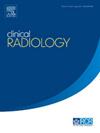Predicting the prognosis of symptomatic intracranial atherosclerotic stenosis (sICAS) patients using deep learning models: a multicenter study based on high-resolution magnetic resonance vessel wall imaging
IF 1.9
3区 医学
Q2 RADIOLOGY, NUCLEAR MEDICINE & MEDICAL IMAGING
引用次数: 0
Abstract
AIM
Symptomatic intracranial atherosclerotic stenosis (sICAS) is a leading cause of stroke recurrence. This study aimed to develop a deep learning model based on high-resolution vessel wall imaging (HR-VWI) to improve recurrence prediction, identify high-risk patients, and guide clinical intervention.
MATERIALS AND METHODS
We retrospectively collected HR-VWI data from 363 patients with sICAS across two medical centres. Centre 1 (n = 254) served as the training cohort, and centre 2 (n = 109) served as the external validation cohort. Three deep learning models—ResNet50, DenseNet169, and Vision Transformer (ViT)—were used to extract features from both 2D and 3D images of culprit plaques. In addition, radiomics-based machine learning models were constructed using manually extracted features. The Least Absolute Shrinkage and Selection Operator (LASSO) algorithm was applied for feature selection, and a Naive Bayes classifier was used to predict the risk of stroke recurrence. Model performance was evaluated using the area under the curve (AUC), calibration curves, and decision curve analysis (DCA).
RESULTS
The 3D-ResNet50 (AUC = 0.780, 95% confidence interval [CI]: 0.638-0.92) and 3D-DenseNet169 (AUC = 0.780, 95% CI: 0.641-0.919) models significantly outperformed 2D models: 2D-ResNet50 (AUC = 0.574, 95% CI: 0.416-0.719), 2D-DenseNet169 (AUC = 0.660, 95% CI: 0.533-0.788), and radiomics (AUC = 0.698, 95% CI: 0.579-0.810). Delong's test confirmed the significance of these differences. Calibration and DCA curves further underscored the 3D models' clinical value.
CONCLUSION
The 3D deep learning model based on HR-VWI offers superior prediction of sICAS recurrence risk compared to 2D models and radiomics, aiding clinical decision-making and high-risk patient identification.
使用深度学习模型预测症状性颅内动脉粥样硬化性狭窄(sICAS)患者的预后:一项基于高分辨率磁共振血管壁成像的多中心研究
目的:症状性颅内动脉粥样硬化性狭窄(sICAS)是卒中复发的主要原因。本研究旨在建立基于高分辨率血管壁成像(HR-VWI)的深度学习模型,以提高复发预测,识别高危患者,指导临床干预。材料和方法:我们回顾性收集了来自两个医疗中心的363例sICAS患者的HR-VWI数据。中心1 (n = 254)作为训练队列,中心2 (n = 109)作为外部验证队列。三个深度学习模型——resnet50、DenseNet169和Vision Transformer (ViT)——被用来从二维和三维图像中提取罪魁祸首斑块的特征。此外,利用人工提取的特征构建了基于放射学的机器学习模型。采用最小绝对收缩和选择算子(LASSO)算法进行特征选择,采用朴素贝叶斯分类器预测脑卒中复发风险。使用曲线下面积(AUC)、校准曲线和决策曲线分析(DCA)来评估模型的性能。结果:3D-ResNet50 (AUC = 0.780, 95%可信区间[CI]: 0.638-0.92)和3D-DenseNet169 (AUC = 0.780, 95% CI: 0.641-0.919)模型明显优于2D模型:2D- resnet50 (AUC = 0.574, 95% CI: 0.416-0.719)、2D- densenet169 (AUC = 0.660, 95% CI: 0.533-0.788)和放射组学(AUC = 0.698, 95% CI: 0.579-0.810)。德龙的试验证实了这些差异的显著性。校正曲线和DCA曲线进一步强调了三维模型的临床价值。结论:基于HR-VWI的3D深度学习模型预测sICAS复发风险优于2D模型和放射组学,有助于临床决策和高危患者识别。
本文章由计算机程序翻译,如有差异,请以英文原文为准。
求助全文
约1分钟内获得全文
求助全文
来源期刊

Clinical radiology
医学-核医学
CiteScore
4.70
自引率
3.80%
发文量
528
审稿时长
76 days
期刊介绍:
Clinical Radiology is published by Elsevier on behalf of The Royal College of Radiologists. Clinical Radiology is an International Journal bringing you original research, editorials and review articles on all aspects of diagnostic imaging, including:
• Computed tomography
• Magnetic resonance imaging
• Ultrasonography
• Digital radiology
• Interventional radiology
• Radiography
• Nuclear medicine
Papers on radiological protection, quality assurance, audit in radiology and matters relating to radiological training and education are also included. In addition, each issue contains correspondence, book reviews and notices of forthcoming events.
 求助内容:
求助内容: 应助结果提醒方式:
应助结果提醒方式:


